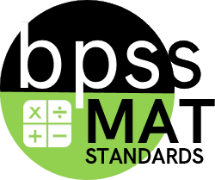MAT-03.G
Narrative for the (G) Geometry DomainGrade 3 students analyze, compare, and classify two-dimensional shapes by their properties. They explicitly relate and combine these classifications. Because they have built a firm foundation of several shape categories, these categories can be the foundation for thinking about the relationships between classes. Students investigate, describe, and reason about decomposing and composing polygons to make other polygons. Problems such as finding all the possible different compositions of a set of shapes involve geometric problem solving and understanding of congruence and symmetry Students in Grade 3 also develop more competence in the composition and decomposition of rectangular regions, spatially structuring rectangular arrays. They count by the number of columns or rows, or use multiplication to determine the number of squares in the array. Calculation Method for DomainsDomains are larger groups of related standards. The Domain Grade is a calculation of all the related standards. Click on the standard name below each Domain to access the learning targets and rubrics/ proficiency scales for individual standards within the domain. | |
MAT-03.G.01MAT-03.G.01 Understand that shapes in different categories (e.g., rhombuses, rectangles, and others) may share attributes (e.g., having four sides), and that the shared attributes can define a larger category (e.g., quadrilaterals). Recognize rhombuses, rectangles, and squares as examples of quadrilaterals. Draw examples of quadrilaterals that do not belong to any of these subcategories. |
MAT-03.G.02Under Development
Student Learning Targets:Knowledge Targets
Reasoning Targets
Skills (Performance) Targets
Product Targets
Proficiency (Rubric) Scale
ResourcesWebsites
Vocabulary
| ||||||||||||||||||||||||||||||||||||||||
MAT-03.MD
Narrative for (MD) Measurement and DataStudents in Grade 3 learn to solve a variety of problems involving measurement and such attributes as length and area, liquid volume, mass, and time.They focus on solving real-world and mathematical problems involving perimeters of polygons. Third graders also focus on learning area. Students learn formulas to compute area, with those formulas based on, and summarizing, a firm conceptual foundation about what area is. As students work with data in Grades K–5, they build foundations for their study of statistics and probability in Grades 6 and beyond, and they strengthen and apply what they are learning in arithmetic. In Grades 3–5, work with data is closely related to the number line, fraction concepts, fraction arithmetic, and solving problems that involve the four operations. In Grade 3, the most important development in data representation for categorical data is that students now draw picture graphs in which each picture represents more than one object, and they draw bar graphs in which the height of a given bar in tick marks must be multiplied by the scale factor in order to yield the number of objects in the given category. These developments connect with the emphasis on multiplication in this grade. At the end of Grade 3, students can draw a scaled picture graph or a scaled bar graph to represent a data set with several categories (six or fewer categories). Calculation Method for DomainsDomains are larger groups of related standards. So the DomainGrade is a calculation of all the related standards. So click on the standard name below each Domain to access the learning targets and proficiency scales for each Domain's related standards. | |
MAT-03.MD.02Under Development
Student Learning Targets:Knowledge Targets
Reasoning Targets
Skills (Performance) Targets
Product Targets
Proficiency (Rubric) Scale
ResourcesWebsites
Vocabulary
| ||||||||||||||||||||||||||||||||||||||||
MAT-03.MD.03MAT-03.MD.03 Draw scaled picture graphs and scaled bar graphs to represent data sets with several categories. Solve one- and two-step “how many more” and “how many less” problems using information presented in scaled bar graphs. |
MAT-03.MD.04Under Development
Student Learning Targets:Knowledge Targets
Reasoning Targets
Skills (Performance) Targets
Product Targets
Proficiency (Rubric) Scale
ResourcesWebsites
Vocabulary
| ||||||||||||||||||||||||||||||||||||||||
MAT-03.MD.05Under Development
Student Learning Targets:Knowledge Targets
Reasoning Targets
Skills (Performance) Targets
Product Targets
Proficiency (Rubric) Scale
ResourcesWebsites
Vocabulary
| ||||||||||||||||||||||||||||||||||||||||
MAT-03.MD.05.aUnder Development
Student Learning Targets:Knowledge Targets
Reasoning Targets
Skills (Performance) Targets
Product Targets
Proficiency (Rubric) Scale
ResourcesWebsites
Vocabulary
| ||||||||||||||||||||||||||||||||||||||||
MAT-03.MD.05.bUnder Development
Student Learning Targets:Knowledge Targets
Reasoning Targets
Skills (Performance) Targets
Product Targets
Proficiency (Rubric) Scale
ResourcesWebsites
Vocabulary
| ||||||||||||||||||||||||||||||||||||||||
MAT-03.MD.06Under Development
Student Learning Targets:Knowledge Targets
Reasoning Targets
Skills (Performance) Targets
Product Targets
Proficiency (Rubric) Scale
ResourcesWebsites
Vocabulary
| ||||||||||||||||||||||||||||||||||||||||
MAT-03.MD.07Under Development
Student Learning Targets:Knowledge Targets
Reasoning Targets
Skills (Performance) Targets
Product Targets
Proficiency (Rubric) Scale
ResourcesWebsites
Vocabulary
| ||||||||||||||||||||||||||||||||||||||||
MAT-03.MD.07.aUnder Development
Student Learning Targets:Knowledge Targets
Reasoning Targets
Skills (Performance) Targets
Product Targets
Proficiency (Rubric) Scale
ResourcesWebsites
Vocabulary
| ||||||||||||||||||||||||||||||||||||||||
MAT-03.MD.07.bUnder Development
Student Learning Targets:Knowledge Targets
Reasoning Targets
Skills (Performance) Targets
Product Targets
Proficiency (Rubric) Scale
ResourcesWebsites
Vocabulary
| ||||||||||||||||||||||||||||||||||||||||
 Domain (G)
Domain (G) Domain (MD)
Domain (MD)